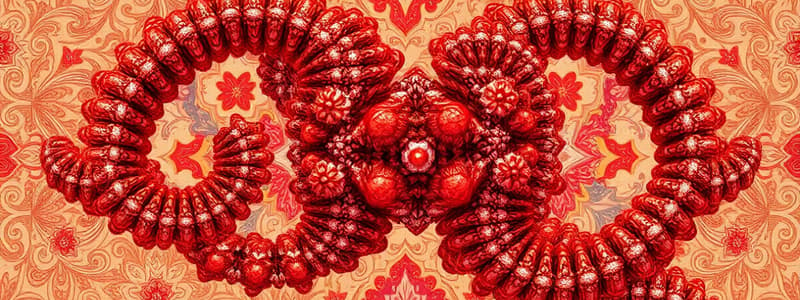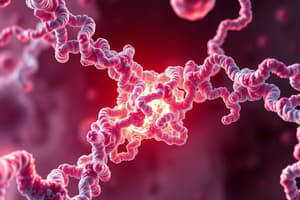Podcast
Questions and Answers
Which of the following best describes the quaternary structure of proteins?
Which of the following best describes the quaternary structure of proteins?
- Interaction between individual amino acids
- Formation of a single polypeptide chain
- Stability provided by hydrogen bonds alone
- Interactions between polypeptide subunits (correct)
Protein folding is always aided by chaperone proteins.
Protein folding is always aided by chaperone proteins.
False (B)
What type of bond connects monosaccharides in a disaccharide?
What type of bond connects monosaccharides in a disaccharide?
Glycosidic bond
___ is a type of polysaccharide that serves as the chief energy storage molecule in plants.
___ is a type of polysaccharide that serves as the chief energy storage molecule in plants.
Match the following carbohydrates with their descriptions:
Match the following carbohydrates with their descriptions:
What type of acid is DNA composed of?
What type of acid is DNA composed of?
Saturated fatty acids contain double bonds in their structure.
Saturated fatty acids contain double bonds in their structure.
What are the two types of bonds that hold the DNA strands together?
What are the two types of bonds that hold the DNA strands together?
Cholesterol acts as a precursor for ______ hormones.
Cholesterol acts as a precursor for ______ hormones.
Match the following lipids to their functions:
Match the following lipids to their functions:
Which base pairs are formed in DNA according to Watson-Crick base pairing?
Which base pairs are formed in DNA according to Watson-Crick base pairing?
Unsaturated fatty acids can be found only in trans configuration.
Unsaturated fatty acids can be found only in trans configuration.
What are the components of a nucleotide?
What are the components of a nucleotide?
Which type of membrane protein spans the entire membrane?
Which type of membrane protein spans the entire membrane?
Cholesterol decreases membrane fluidity at low temperatures.
Cholesterol decreases membrane fluidity at low temperatures.
What is the main function of gap junctions?
What is the main function of gap junctions?
_______ are made from actin and are involved in cellular motility.
_______ are made from actin and are involved in cellular motility.
Match the type of junction with its function:
Match the type of junction with its function:
Which solution has a higher relative solute concentration than the cell's interior?
Which solution has a higher relative solute concentration than the cell's interior?
Osmosis refers to the diffusion of solutes.
Osmosis refers to the diffusion of solutes.
What structural arrangement characterizes eukaryotic flagella and cilia?
What structural arrangement characterizes eukaryotic flagella and cilia?
What is the primary function of the Golgi Apparatus?
What is the primary function of the Golgi Apparatus?
Chloroplasts are responsible for photosynthesis in animal cells.
Chloroplasts are responsible for photosynthesis in animal cells.
What are ribosomes primarily responsible for in cell biology?
What are ribosomes primarily responsible for in cell biology?
The ______ is responsible for breaking down toxins in liver cells.
The ______ is responsible for breaking down toxins in liver cells.
Match the following organelles with their primary functions:
Match the following organelles with their primary functions:
Which of the following structures is NOT present in plant cells?
Which of the following structures is NOT present in plant cells?
The plasma membrane is composed primarily of a phospholipid bilayer.
The plasma membrane is composed primarily of a phospholipid bilayer.
What type of molecule composes the cell wall in plant cells?
What type of molecule composes the cell wall in plant cells?
The organelle known for oxidative phosphorylation is the ______.
The organelle known for oxidative phosphorylation is the ______.
Which of the following correctly describes peroxisomes?
Which of the following correctly describes peroxisomes?
What is the primary product of the Calvin Cycle?
What is the primary product of the Calvin Cycle?
Higher concentrations of CO2 favor photorespiration over the Calvin Cycle.
Higher concentrations of CO2 favor photorespiration over the Calvin Cycle.
What enzyme catalyzes the reaction during carbon fixation?
What enzyme catalyzes the reaction during carbon fixation?
The Calvin Cycle requires _____ cycles to produce a single glucose molecule.
The Calvin Cycle requires _____ cycles to produce a single glucose molecule.
Match each process with its description:
Match each process with its description:
What role does NADPH play in the Calvin Cycle?
What role does NADPH play in the Calvin Cycle?
C3 plants exclusively use the Calvin Cycle for carbon fixation.
C3 plants exclusively use the Calvin Cycle for carbon fixation.
What effect does closing stomata have on CO2 and O2 concentrations inside the leaf?
What effect does closing stomata have on CO2 and O2 concentrations inside the leaf?
Study Notes
Quaternary Structure
- Quaternary structure refers to the arrangement and interactions between multiple polypeptide chains, known as subunits.
- Interactions can involve disulfide bridges, salt bridges, and intermolecular forces.
Protein Folding
- Protein folding can occur spontaneously without assistance.
- Chaperone proteins can aid in correct folding.
- Denaturation may occur due to pH changes, high salt concentrations, organic solvents, or elevated temperatures.
Carbohydrates
- Monosaccharides, the basic units of carbohydrates, have the formula Cn(H2O)n and can be either aldoses or ketoses.
- Monosaccharides can cyclize to form hemi-acetals/hemi-ketals.
- Disaccharides consist of two linked monosaccharides via glycosidic bonds (e.g., sucrose = glucose + fructose).
- Polysaccharides are long chains of monosaccharides; starch serves as the primary energy storage in plants.
- Amylose is linear (α-(1-4) bonds), while amylopectin is branched (α-(1-4) and α-(1-6) bonds).
- Glycogen is a branched glucose polymer used for energy storage in animal muscles and liver.
- Cellulose, a linear glucose polymer with β-(1-4) bonds, provides structural support in plant cell walls.
- Chitin, made of N-acetylglucosamine, is found in fungal cell walls and arthropod exoskeletons.
Nucleic Acids
- DNA consists of deoxyribose sugar, and RNA consists of ribose sugar with bases A, C, G, T (for DNA) and A, C, G, U (for RNA).
- DNA has a right-handed double helix structure (B-form) with antiparallel, complementary strands held together by hydrogen bonds.
- Watson-Crick base pairing includes A-T (2 hydrogen bonds) and G-C pairs (3 hydrogen bonds).
Lipids
- Lipids are hydrophobic and insoluble in water, playing diverse roles in biological systems.
- Key lipid types:
- Triglycerides for energy storage and insulation.
- Phospholipids form cell membranes.
- Cholesterol adds membrane fluidity and is a steroid precursor.
- Steroids function as hormones.
- Sphingolipids and prostaglandins play roles in cellular signaling and the nervous system.
- Terpenes are involved in plant functions and cholesterol biosynthesis.
Fatty Acids
- Fatty acids are carboxylic acids with long hydrocarbon chains.
- Saturated fatty acids have no double bonds; unsaturated can have one (monounsaturated) or more (polyunsaturated).
- Triglycerides consist of three fatty acids bonded to glycerol and are stored in adipose tissue.
Phospholipids
- Phospholipids are crucial for cell membranes, being amphipathic with hydrophilic heads and hydrophobic tails.
- Unsaturated phospholipids enhance membrane fluidity due to loose packing.
Steroids and Cholesterol
- Cholesterol contributes to membrane fluidity and is a precursor for steroid hormones and bile.
Organelles
- Nucleus: Stores DNA, site of transcription, contains the nucleolus for rRNA synthesis.
- Ribosomes: Sites of protein synthesis, existing as free ribosomes or attached to the rough ER.
- Rough ER: Involved in glycoprotein synthesis and production of phospholipids and steroids.
- Smooth ER: Functions in detoxification, lipid synthesis, and carbohydrate metabolism.
- Golgi Apparatus: Modifies, sorts, and packages proteins for secretion or transport.
- Mitochondria: Powerhouse of the cell; ATP synthesis, fatty acid catabolism, contains its own DNA.
- Lysosomes: Digestive organelles that break down waste materials.
- Peroxisomes: Involved in fatty acid degradation and detoxification processes.
- Centrosomes and Centrioles: Microtubule-organizing centers critical for cell division.
- Vacuoles: Storage organelles, large central vacuole in plant cells maintains turgor pressure.
- Chloroplasts: Sites of photosynthesis in plant cells.
Plasma Membrane
- Composed of a phospholipid bilayer, follows the fluid mosaic model.
- Components:
- Phospholipids and glycolipids for structure, affecting fluidity.
- Cholesterol modulates membrane fluidity based on temperature.
- Membrane proteins include peripheral, integral, and transmembrane proteins, with roles in transport and signaling.
Intercellular Junctions
- Gap Junctions: Allow nutrient exchange and communication between cells (e.g., cardiac muscle).
- Tight Junctions: Prevent leakage between cells (e.g., intestinal cells).
- Desmosomes: Provide mechanical strength and adhesion between cells.
Cytoskeleton
- Microfilaments: Comprised of actin, involved in cell movement and division.
- Intermediate Filaments: Provide structural support to the cell.
- Microtubules: Tubulin-based, serve as tracks for intracellular transport and are key components of mitotic spindles and cilia/flagella.
Membrane Transport
- Diffusion: Movement of solute from high to low concentration.
- Osmosis: Water movement across a membrane.
- Solutions categorized as hypertonic, hypotonic, or isotonic based on solute concentration differences.
Calvin Cycle
- Carbon fixation processes occur in three stages:
- Carbon Fixation (using Rubisco to convert CO2 into 3-phosphoglycerate).
- Reduction (produces glyceraldehyde-3-phosphate using ATP and NADPH).
- Regeneration (converts glyceraldehyde-3-phosphate back into ribulose-1,5-bisphosphate, utilizing ATP).
Photorespiration
- Photorespiration occurs when Rubisco catalyzes the oxidation of ribulose-1,5-bisphosphate, competing with carbon fixation.
- Higher O2 concentrations and temperatures increase photorespiration, affecting overall photosynthesis efficiency.
- Stomata regulate gas exchange; closure under high temperatures limits CO2 uptake and increases O2, exacerbating photorespiration.
C4 Photosynthesis
- C4 plants utilize a different pathway for carbon fixation, allowing efficient functioning in high temperatures and light intensities.
Studying That Suits You
Use AI to generate personalized quizzes and flashcards to suit your learning preferences.
Related Documents
Description
This quiz explores the quaternary structure of hemoglobin, focusing on how multiple polypeptide chains interact to form functional proteins. Additionally, it covers the role of disulfide bridges, salt bridges, and intermolecular forces in protein stability and folding. Test your understanding of these critical concepts in biochemistry.




